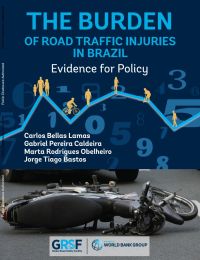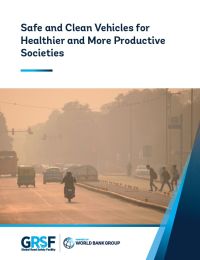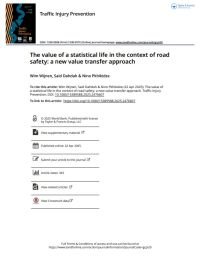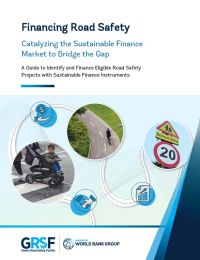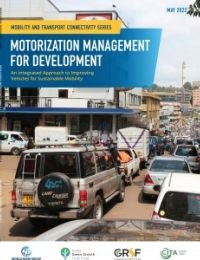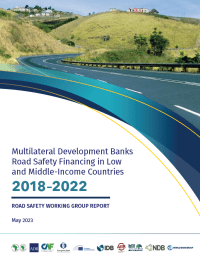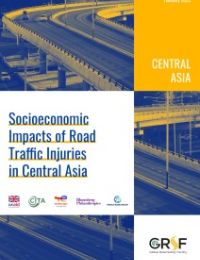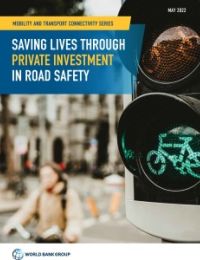Publications
1-8 of 8
-
-
-
Economics & Finance
Journal Article - The Value of a Statistical Life in the Context of Road Safety: A New Value Transfer Approach
May 2025
-
Economics & Finance
Financing Road Safety: Catalyzing the Sustainable Finance Market to Bridge the Gap
February 2025
-
Economics & Finance
Multilateral Development Banks Road Safety Financing in Low and Middle-Income Countries: 2018–2022
May 2023
-
-
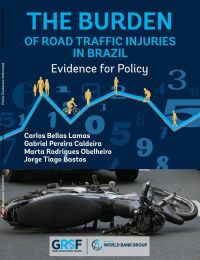
This study evaluates injuries, disabilities, deaths, and associated costs resulting from traffic crashes in Brazil, while suggesting policies to reduce long-term disability and societal impact. In addition to estimating the costs associated with RTIs, the study also addresses factors within the transport system that have an effect on road safety in Brazil, and incorporates these insights into policy recommendations aimed at reversing the cycle of dangerous road crashes.

The rapid growth of motorization in emerging and developing economies brings new opportunities—but also rising health and economic risks. Safe and Clean Vehicles for Healthier and More Productive Societies presents compelling evidence that poor-quality vehicles are a major contributor to road traffic deaths, long-term disability, and air pollution.
The report emphasizes that electrification alone is not enough. Instead, countries must adopt comprehensive motorization management policies, including regulating used vehicle imports, enforcing modern safety and emissions standards, and retiring unsafe vehicles.
These strategies can significantly reduce fatalities and serious injuries, protect human capital, and promote cleaner, more resilient transport systems.
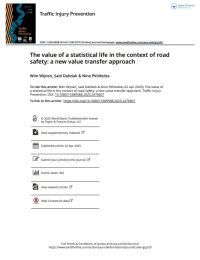
Objective: The value of a statistical life (VSL) is a key input for cost-benefit analysis (CBA) in the context of road safety and for calculations of the socio-economic costs of road crashes. However, many countries, especially low- and middle-income countries (LMIC), lack country-specific VSL estimates. To address this, value transfer is often used, where VSL estimates from other countries are adapted to local situations to estimate the VSL in the countries with no VSL estimates. This paper presents new guidance for VSL value transfer in the context of road safety.
Method: A unit value transfer approach is applied, which implies that a base VSL is determined and used to estimate the VSL in other countries. We collected VSL estimates from 32 countries worldwide to determine base VSLs for both high-income countries (HIC) and LMIC. According to the literature, the VSL is strongly correlated with income per capita. Therefore, income elasticities from the literature are applied to account for the impact of per capita income on the VSL.
Results: The resulting VSL transfer functions are VSL = 0.404*(Y/5,726)1.2 for LMIC and VSL = 3.206*(Y/42,087)0.8 for HIC, where VSL is the VSL in million USD and Y is the Gross National Income per capita (USD, 2020 prices). The VSL ranges from approximately 22,000 USD to 1.1 million USD in LMIC and from 1.2 million USD to 4.8 million USD in HIC.
Conclusions: We recommend applying this VSL transfer approach for cost-benefit analysis and road crash costing in countries lacking appropriate country-specific VSL. Moreover, this study highlights that, despite the growing interest in LMIC in research on VSL, the number of studies in these countries is still limited, emphasizing the need for more VSL studies. Finally, developing transfer functions for non-fatal injuries is recommended, which is an essential input for CBA as well.
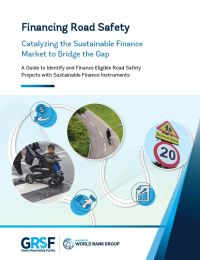
The burden of road traffic injuries is a significant global challenge requiring urgent attention and investment. By integrating road safety investments with broader development goals and leveraging innovative financing solutions such as labeled sustainable bonds and loans, available financing for road safety projects can be dramatically increased.
The societal, economic, and human benefits of improving road safety are extensive, making it a critical priority for national agendas. Through strategic investments in road safety, economic burdens can be mitigated, long-term growth promoted, and a safer, more equitable world created for all.
The multilateral development banks -- together with the Global Road Safety Facility and with strong donor support -- can help countries catalyze the sustainable finance market to fund high-impact and results-oriented road safety projects.
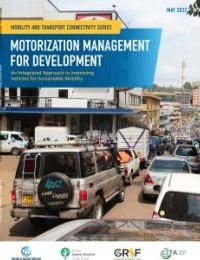
Across the developing world, countries are experiencing rapid growth in urbanization and motorization. While high motorization rates potentially meant hat more people will be able to claim the benefits of improved accessibility to goods and services as a consequence of enhanced mobility, there are questions about the sustainability of this future. Will countries be able to build and maintain infrastructure to accommodate increasing numbers of vehicles? Will the increasing number of vehicles and their characteristics support attainment of the Sustainable Development Goals (SDGs) Will they put in jeopardy countries’ ability to meet their climate commitments under their Nationally Determined Contributions (NDCs)? From a development impact standpoint, the nature of a country’s motor vehicle stock and how it grows affects three key and tangible outcomes.
First, the quality of the motor vehicle stock affects road safety outcomes—that is, the number of people killed or seriously injured in motor vehicle crashes. The characteristics of vehicles and their fitness or roadworthiness can affect fatality and serious injury outcomes. Second, the quality of the motor vehicle fleet affects air quality, particularly in cities. Motor vehicles are a key source of harmful air pollution, including carbon monoxide (CO), fine particulates (PM2.5), sulfur oxides (SOx), and ozone precursors (oxides of nitrogen and various hydrocarbons), and the amount of these pollutants they emit is directly related to how the vehicle was built and how well it is maintained. Finally, the profile of the vehicle fleet—what is the size and weight of vehicles in the fleet, how big are their engines, what kind of power control technology do they use, and how did their manufacturers engineer the technology of the vehicle to balance power with efficiency—affects the (fossil) fuel consumption of the vehicle stock as a whole, and, consequently, the greenhouse gas (GHG) emissions profile of the road transport sector.
This report presents the World Bank’s Motorization Management (MM) framework, which is intended to support client countries in the development of policies and measures aimed at managing vehicle stocks in a proactive, phased, and systematic manner to make them safer, cleaner, and more fuel efficient. The MM framework reflects a series of policy considerations and programs that can be implemented to improve the quality of fuels and vehicles in a country’s stock.
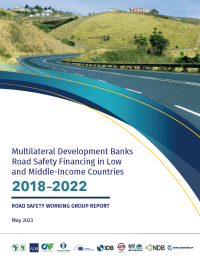
The Multilateral Development Banks (MDBs) Road Safety Working Group, established in 2009, is comprised of ten member institutions that are uniquely positioned to support countries in reaching their considerable and challenging road safety financing needs.
In early 2023, the working group reviewed progress made by the MDBs in financing road safety activities in low and middle-income countries (LMICs), and found that MDBs collectively committed $3.6 billion toward road safety initiatives in developing countries during the period 2018-2022. Three standalone road safety projects—in Bangladesh (World Bank), India (Asian Development Bank and World Bank), and Romania (European Investment Bank)—totaled $912 million in MDBs financing, which is more than one-quarter of the amount committed during this timeframe.
The review is based on details of road and urban mobility project financing provided by seven of the working group's ten members.
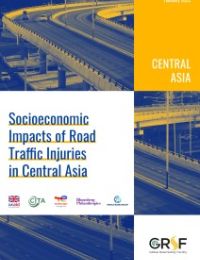
Road traffic injuries (RTIs) are well known to cause enormous human suffering in terms of both morbidity and mortality, and on a global scale. The economic dimension of the disease burden is far less well understood; but it is important to assess the size of the economic burden so that it can be considered when calculating the cost-benefit ratio of policies to tackle this problem. Because it is, in principle, and to some degree, an avoidable one.
This report focuses primarily on assessing various dimensions of the economic consequences of RTIs, as applied specifically to four Central Asian countries (Kazakhstan, Kyrgyzstan, Tajikistan, and Uzbekistan) – a part of the world in which there is still a major need to reduce RTIs.
This study shows that on top of the harm RTIs inflict upon human health, they also impose a considerable financial burden on health care systems. In 2016, the total estimated health costs of RTIs in these four countries was approximately Int$95 million, ranging from Int$2.8million in Tajikistan to Int$49.3 million in Kazakhstan. In Kazakhstan, the overall health costs resulting from RTIs were similar to the cumulative expenditure for rehabilitative and palliative care within the state-guaranteed basic package. The heavy financial burden on health care systems to manage RTIs in these countries adds weight to the urgency to increase preventive efforts by road safety policymakers, and should motivate appropriate organization of the post-crash response by health care system decision makers. The cost estimates discussed in this report indicate the potential for significant economic cost savings if both deaths and injuries from road crashes could be substantially reduced in these countries.
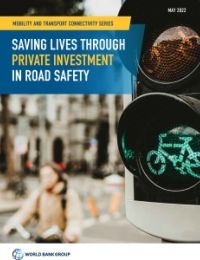
The World Bank estimates a significant funding gap in road safety of 260 billion to achieve SDG 3.6 and 11.2 in the next ten years, and recognizes that this gap cannot be closed through public funding alone and thus mobilization of private capital is required. The impacts of road traffic crashes reach far into the economy and can cost L/MICs as much as 6% of their GDP. The costs of a road traffic crash do not end at the roadside; they create ripple effects throughout the wider economy. Loss of income, property damage, insurance premiums, loss of taxes, and burdens on the health sector are just some of the far-reaching costs associated with road traffic crashes. Road traffic crashes can cost countries as much as 6 percent of their GDP and trap families in poverty as they lose income generating potential and focus on providing lifetime care.
This report examines the potential for private capital mobilization to close this gap. The report investigates the market failure to appropriately account for the cost of road crashes, which prevents private capital from flowing to road safety investments. The growth of socially responsible investing and the sustainable finance market offers a new opportunity to address this market failure. The report proposes different business models and financing instruments to channel private investment into road safety projects. These investment structures consist of subnational, public-private partnerships (PPPs) and corporate investments that can leverage the growing sustainable finance market, including social and sustainability-linked financings (SLFs).
The report also develops indicators that can be used to tie the cost of financing to the attainment of road safety targets, incentivizing borrowers to commit to road safety as part of SLFs. The report examines the enabling environment for structuring investable road safety projects in a sample of countries, looking at the barriers and opportunities, and proposing risks and mitigation strategies, like blended finance mechanisms and stable revenue sources, for long-term sustainability of road safety investments.

